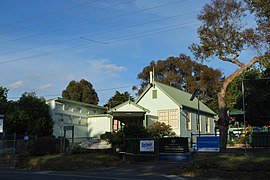Yering, Victoria
| Yering Victoria | |||||||||||||||
|---|---|---|---|---|---|---|---|---|---|---|---|---|---|---|---|
 Yering Primary School | |||||||||||||||
| Population | 138 (SAL 2021)[1] | ||||||||||||||
| Established | 1845 | ||||||||||||||
| Postcode(s) | 3770 | ||||||||||||||
| Elevation | 152 m (499 ft) | ||||||||||||||
| Location | |||||||||||||||
| LGA(s) | Shire of Yarra Ranges | ||||||||||||||
| State electorate(s) | Evelyn | ||||||||||||||
| Federal division(s) | Casey | ||||||||||||||
| |||||||||||||||
Yering is a town in Victoria, Australia, 38 km north-east from Melbourne's central business district. Its local government area is the Shire of Yarra Ranges.
Yering was home to one of Victoria's first wineries.
History
In 1837, brothers William, Donald and James Ryrie, accompanied by four convict stockmen, set out from the Monaro region of New South Wales driving 250 head of stock, settling in the Yarra Valley at Yering, which was the Indigenous name for the local area.[2] They also brought wines with them, and when visitors came to the property, they were treated to wine labelled by Donald Ryrie (his brothers having meanwhile returned to New South Wales) as "Chateau Yering" with ironic overstatement.
By the 1850s, the property had been acquired by two immigrant families from Neuchâtel, Switzerland—the de Castella and de Pury families, who founded two other wineries on the property, Yeringberg and St Hubert's. All three won Victorian and international awards, including "Best Victorian Vineyard" in 1861 and, in 1889, at the Paris Exhibition, Yering was awarded the only "Grand Prix" to a winery outside the Northern Hemisphere.
Post Offices opened as St Huberts on 1 January 1874 (renamed Yeringberg in 1890 and closing in 1942), Yering on 1 December 1884 (closing 1893), and Yering R. S. (for Railway Station) on 10 April 1890 (renamed Yering about 1915).[3]
The railway arrived in 1888.
The 1890s Depression saw table wines decline in popularity and the land, for cattle-grazing and dairying purposes, become more valuable than the vines. Paul de Castella sold Chateau Yering in 1896. The area became the centre of a modern revival of Yarra Valley winemaking in the 1960s, with the original wineries coming back into production and many others established.
Present day
The original 1854 mansion on Melba Highway built by Paul de Castella in 1854 from local hand-made bricks and marble and cedar brought overland from New South Wales, is open today with some alterations as the Chateau Yering Historic House/Hotel. Today the original dining room is a restaurant.
Yarra Valley Dairy, with 500 cattle and a range of cheeses, is located just off Melba Highway and offers cheese tasting. Both are accessible by the 685 bus route (Lilydale – Healesville) operated by McKenzie's Tourist Services.
St Hubert's, Domaine Chandon and Yeringberg are located to the east in neighbouring Coldstream. Lilydale Airport, a small airport offering aircraft hire and flying training, is located on McIntyre Lane. Also in Yering is Yering Range Vineyard and Windsor Park Equine Centre, a 247 hectare purpose-built horse agistment property. At the rear of Windsor Park Equine Centre is Yering Gorge Cottages a group of self-contained cottages which overlook the picturesque Yering Gorge on the Yarra River. The Yering Gorge has some unique flora and is home to many native fauna species.
See also
References
- ^ Australian Bureau of Statistics (28 June 2022). "Yering (suburb and locality)". Australian Census 2021 QuickStats. Retrieved 28 June 2022.
- ^ "Yering" derives from either "Yerrang", meaning "scrubby", or "Yerring", meaning "beard". "The A-Z story of Melbourne's suburbs: Yering". Herald Sun. Melbourne. 7 January 2014. Archived from the original on 25 March 2014.
{{cite news}}: Unknown parameter|deadurl=ignored (|url-status=suggested) (help) - ^ Premier Postal History, Post Office List, retrieved 2008-04-11
External links
- Steeped in history, The Age (Travel section), 16 September 2006
- Chateau Yering includes history
- Yarra Valley Dairy the commercial website for Yarra Valley Dairy

